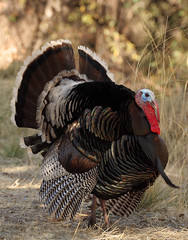 Image via Wikipedia
Image via WikipediaSome other interesting facts about the Wild Turkey (Meleagris gallopavo)
 Image by dracobotanicus via Flickr
Image by dracobotanicus via Flickr• Today, wild turkeys are being reintroduced into many areas across the USA. Overhunting and the disappearance of their favored woodland habitat has resulted in the decline in turkey populations.
• Wild turkeys have very powerful legs and can run faster than 20 miles per hour and fly up to 55 miles per hour.
• To attract mates, males display their fanlike tail, bare head, and bright snood and wattle. They also perform a little turkey trot and make a distinctive gobble that can be heard a mile away. After mating males have little to do with the females.
• Females lay 4 to 17 eggs in a ground nest under a bush, incubate the eggs for up to 28 days and feed their chicks only for a few days after they hatch. Young turkeys quickly learn to fend for themselves as part of mother/child flocks that can include dozens of animals.
• The adult males, known as toms or gobblers, normally weigh between 16 and 24 pounds while the females, known as hens, usually weigh between 8 and 10 pounds. Very young birds are poults, while juvenile males are jakes and females are jennies. A group of turkeys has many collective nouns, including a "crop", "dole", "gang", "posse", and "raffle" of turkeys.
Category ›
Quick fun Facts
 Unknown
Unknown
 Saturday, April 2, 2011
Saturday, April 2, 2011










No comments:
Post a Comment